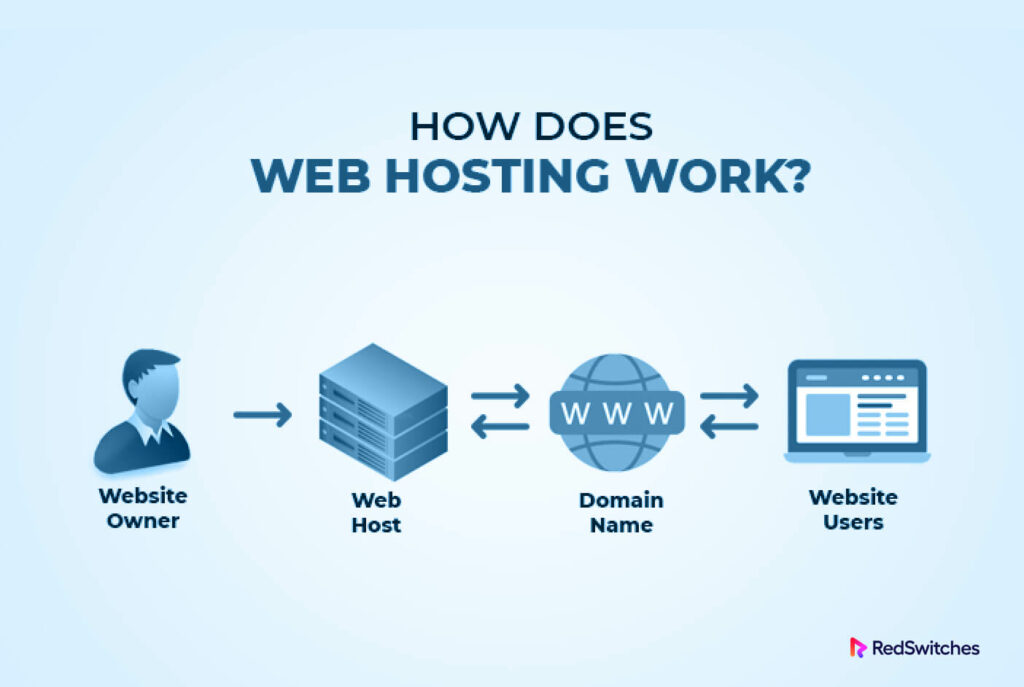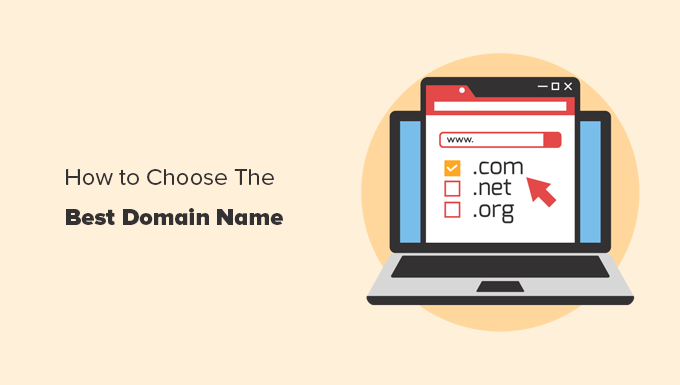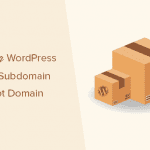A domain name is the address that people type into their web browser to access a specific website. It’s the unique identifier that allows users to find and connect to a particular website or online resource. But have you ever wondered how domain names actually work? In this blog post, we’ll dive into the details of domain names and explore how they function.
What Is a Domain Name?
A domain name is the unique address that people use to access a website on the internet. It is the human-readable version of a website’s internet protocol (IP) address, which is a long string of numbers that identifies the location of a website on the internet.
Some key points about domain names:
- Identification: Domain names provide a more user-friendly way to identify and access websites, compared to remembering complex IP addresses.
- Hierarchy: Domain names are structured hierarchically, with the top-level domain (TLD) on the right, followed by the second-level domain (SLD), and potentially subdomains.
- Uniqueness: Each domain name must be unique, ensuring that there is only one website associated with a particular domain name.
- Registration: Domain names are registered through accredited domain registrars, who maintain the domain name database and ensure the uniqueness of each domain.
- Ownership: While domain names are not owned outright, they are leased by the registrant for a specified period, typically one year, and must be renewed to maintain control over the domain.
- Purpose: Domain names serve as the primary entry point for users to access websites, online services, email, and other internet-based resources.
In summary, a domain name is the human-friendly address that allows users to easily find and access specific websites and online content, rather than having to remember complex numerical IP addresses.
Understanding Domain Names
At its core, a domain name is a human-readable address that corresponds to a unique numerical internet protocol (IP) address. IP addresses are the actual digital identifiers that devices use to communicate with each other on the internet, but they are long, complex, and difficult for people to remember.
Domain names provide a more user-friendly way to access websites and online services. Instead of having to remember a string of numbers like “192.168.1.1”, you can simply type in a memorable name like “www.example.com“.
Domain names are structured in a hierarchical manner, with different levels of the hierarchy separated by periods (also known as “dots”). The rightmost part of the domain name is called the “top-level domain” (TLD), and it indicates the type of organization or the country where the website is located. Common TLDs include .com, .org, .edu, .gov, .net, and country-specific TLDs like .uk, .ca, or .fr.
The part of the domain name that comes before the TLD is called the “second-level domain” (SLD). This is the unique part of the domain name that identifies the specific website or organization. For example, in the domain name “www.example.com“, “example” is the SLD.
Some domain names may also have a “subdomain” before the SLD, such as “blog.example.com” or “support.example.com”. Subdomains are used to further organize and categorize content within a website.
How Domain Names Work

Domain names work by translating the human-readable domain name into the numerical IP address that computers and servers use to communicate on the internet. This process is known as DNS (Domain Name System) resolution, and it involves the following steps:
- Client Request: When a user types a domain name into their web browser (e.g., www.example.com), the browser sends a request to a local DNS server, typically provided by the user’s internet service provider (ISP) or a third-party DNS service.
- DNS Lookup: The local DNS server first checks its own cache to see if it has the IP address associated with the requested domain name. If the IP address is not found in the cache, the DNS server will query other DNS servers higher up in the domain name hierarchy.
- Root Server Lookup: The local DNS server first contacts one of the internet’s “root” DNS servers, which are responsible for directing the request to the appropriate top-level domain (TLD) server, such as the .com or .org TLD server.
- TLD Server Lookup: The TLD server is responsible for knowing the IP addresses of the domain name registrars that manage the second-level domains (SLDs) within that TLD.
- Registrar Lookup: The DNS server then queries the appropriate registrar’s DNS server to find the IP address associated with the specific SLD (e.g., example.com).
- IP Address Response: Once the IP address is found, the registrar’s DNS server sends the IP address back to the original local DNS server, which then sends it back to the user’s web browser.
- Website Connection: The web browser can now use the obtained IP address to establish a connection with the web server hosting the requested website.
This entire process of translating a domain name to an IP address happens very quickly, usually in a fraction of a second, allowing users to access websites seamlessly.
The domain name system is a distributed and hierarchical system, with different DNS servers responsible for different parts of the domain name hierarchy. This structure ensures that the system can scale to handle the vast number of domain names and IP addresses on the internet.
By understanding how domain names work, you can better appreciate the important role they play in the overall functioning of the internet and how they enable users to easily access and navigate the vast array of online resources and services.
How Is Domain Name Different From a Website and Web Hosting?
The domain name, website, and web hosting are distinct but interconnected components that work together to make a website accessible on the internet. Here’s how they differ:
- Domain Name:
- A domain name is the unique web address that users type into their browser to access a website, such as “www.example.com“.
- It serves as the human-readable address that points to the actual location of the website on the internet, which is the web server’s IP address.
- Domain names are registered and managed by domain registrars, which maintain the global database of domain names.
- Website:
- A website is the collection of web pages, images, videos, and other digital content that make up an online presence.
- The website content is created and maintained by the website owner or developer using various web design and development tools.
- The website content is typically stored on a web server, which is responsible for serving the website to users when they access the domain name.
- Web Hosting:
- Web hosting refers to the service that provides the physical server and the necessary infrastructure to store and deliver the website content to users.
- Web hosts, such as GoDaddy, Bluehost, or Amazon Web Services, provide the server space, processing power, and network connectivity required to make a website accessible on the internet.
- Web hosts also often provide additional services, such as domain name registration, email hosting, and website management tools.
The relationship between these three components can be summarized as follows:
- The domain name is the public-facing address that users type to access the website.
- The website is the actual content and design that the user sees and interacts with.
- The web hosting service provides the physical infrastructure and resources to store and deliver the website content to users.
In order for a website to be accessible on the internet, you need all three components: a registered domain name, the website content, and a web hosting service that can deliver the website to users when they access the domain name.
Different Types of Domain Names
There are several different types of domain names, each with its own purpose and characteristics. Here are the main types of domain names:
- Top-Level Domains (TLDs):
- These are the domains at the highest level of the domain name hierarchy, such as .com, .org, .net, .edu, .gov, and country-specific TLDs like .us, .uk, .ca, etc.
- TLDs are managed by the Internet Corporation for Assigned Names and Numbers (ICANN) and its accredited registrars.
- Second-Level Domains (SLDs):
- SLDs are the domains that come immediately after the TLD, such as “example” in “example.com”.
- SLDs are registered and managed by the domain registrars.
- Subdomains:
- Subdomains are additional levels of domains that are placed before the SLD, such as “www” or “blog” in “www.example.com” or “blog.example.com”.
- Subdomains are often used to organize and separate different sections or services of a website.
- Generic Top-Level Domains (gTLDs):
- gTLDs are TLDs that are not country-specific, such as .com, .org, .net, .edu, .gov, and .mil.
- These domains are typically used for commercial, organizational, or educational purposes.
- Country-Code Top-Level Domains (ccTLDs):
- ccTLDs are TLDs that are specific to a particular country or territory, such as .uk for the United Kingdom, .ca for Canada, or .jp for Japan.
- These domains are often used to indicate the geographic location or focus of a website.
- Internationalized Domain Names (IDNs):
- IDNs allow the use of non-Latin characters, such as Chinese, Arabic, or Cyrillic, in domain names.
- This enables the creation of domain names in local languages and scripts, making the internet more accessible to users worldwide.
- Premium Domains:
- Premium domains are desirable, often short and memorable domain names that may have higher registration and renewal fees.
- These domains are often sought after by businesses, organizations, or individuals for their brandability and perceived value.
The choice of domain name type depends on factors such as the website’s purpose, target audience, geographic focus, and the availability and cost of the desired domain name.
Who Is Responsible for the Domain Name System?
The Domain Name System (DNS) is a decentralized and hierarchical system that is primarily managed and overseen by the following organizations and authorities:
- Internet Corporation for Assigned Names and Numbers (ICANN):
- ICANN is the global non-profit organization responsible for the coordination and management of the DNS.
- ICANN oversees the assignment and delegation of top-level domains (TLDs), such as .com, .org, and country-code TLDs (ccTLDs) like .us and .uk.
- ICANN also manages the root zone file, which contains the authoritative list of all top-level domains and their corresponding nameservers.
- Domain Name Registrars:
- Domain name registrars are accredited by ICANN to register and manage second-level domain names (SLDs) within the TLDs.
- Registrars are responsible for selling and managing domain name registrations, renewals, and transfers to end-users.
- Examples of popular domain registrars include GoDaddy, Namecheap, Google Domains, and Network Solutions.
- Root Server Operators:
- The root servers are a network of 13 main servers that form the foundation of the DNS hierarchy.
- These servers are operated by various organizations, government agencies, and universities around the world, including the U.S. Department of Defense, VeriSign, and the Internet Systems Consortium.
- The root servers are responsible for directing DNS queries to the appropriate TLD servers.
- TLD Registries:
- TLD registries are responsible for managing the authoritative DNS servers and zone files for their respective top-level domains.
- Examples include Verisign for .com and .net, Public Interest Registry for .org, and country-specific registries for ccTLDs like .uk and .cn.
- Internet Service Providers (ISPs) and DNS Resolvers:
- ISPs and other DNS resolver services, such as Google DNS and Cloudflare DNS, provide the DNS lookup services for end-users.
- These DNS resolvers cache DNS records and query the appropriate servers to resolve domain names to IP addresses.
The collaborative efforts of these organizations and authorities ensure the proper functioning, stability, and security of the global Domain Name System, which is essential for the overall operation of the internet.
How to Choose a Domain Name for Your Website

Choosing the right domain name for your website is an important decision that can have a significant impact on your online presence and success. Here are some key factors to consider when selecting a domain name:
- Relevance and Branding:
- Choose a domain name that is relevant to your business, product, or service, and helps convey your brand identity.
- Ideally, the domain name should be memorable, easy to spell, and relate to your website’s content or purpose.
- Keyword Targeting:
- If possible, try to incorporate relevant keywords in your domain name, as this can improve your website’s search engine optimization (SEO) and visibility.
- However, avoid keyword stuffing or using overly generic domain names, as this can be seen as spammy by search engines.
- Availability and Uniqueness:
- Check the availability of your desired domain name across all the major top-level domains (TLDs), such as .com, .org, and .net.
- Ensure that the domain name is unique and not already in use by another website or organization, as this can lead to legal issues or brand confusion.
- Length and Simplicity:
- Shorter domain names are generally more memorable and easier to share, so aim for a concise and straightforward domain name if possible.
- Avoid using hyphens, numbers, or unusual spellings, as these can make the domain name harder to remember and type correctly.
- Future Scalability:
- Consider the future growth and expansion of your website or business when choosing a domain name.
- Opt for a domain name that is flexible enough to accommodate changes or additions to your website’s content and offerings.
- Trademark and Legal Considerations:
- Ensure that the domain name you choose does not infringe on any existing trademarks or intellectual property rights.
- Research the legal landscape and consult with a professional if you have any concerns about potential trademark issues.
- Top-Level Domain (TLD) Selection:
- Choose a TLD that is appropriate for your website’s purpose and target audience.
- The most common and recognizable TLD is .com, but other options like .org, .net, and country-specific TLDs (e.g., .us, .ca) may also be suitable.
By considering these factors, you can select a domain name that not only represents your brand and website but also helps improve your online visibility, search engine rankings, and overall user experience.
How to Buy a Domain Name
Purchasing a domain name can be a straightforward process, but there are a few steps to follow to ensure a smooth and successful transaction. Here’s a general guide on how to buy a domain name:
- Determine the Domain Name:
- Research and identify the domain name you want to purchase, considering factors like relevance, branding, availability, and future scalability.
- Check Domain Availability:
- Use a domain name registrar’s search tool to check if the domain name you want is available for registration.
- If the domain is already registered, you may need to consider alternative options or explore the possibility of purchasing it from the current owner.
- Choose a Domain Registrar:
- Select a reputable and accredited domain name registrar, such as GoDaddy, Namecheap, Google Domains, or Network Solutions.
- Consider factors like pricing, customer support, additional features, and the registrar’s reputation.
- Complete the Registration Process:
- On the registrar’s website, navigate to the domain registration page and enter the desired domain name.
- Provide the necessary information, such as your contact details and payment information.
- Review the terms of service and privacy policy before completing the purchase.
- Select the Registration Period:
- Most registrars offer domain registrations for periods ranging from 1 year to 10 years or more.
- Choose a registration period that suits your needs and budget, keeping in mind the domain renewal process and costs.
- Provide Accurate Contact Information:
- Ensure that you provide accurate and up-to-date contact information, including your name, address, email, and phone number.
- This information is required for the domain’s WHOIS record, which is publicly accessible.
- Complete the Payment:
- Proceed with the payment using your preferred method, such as a credit card, PayPal, or other secure payment options.
- Confirm the total cost, which may include the domain registration fee and any additional services or features you choose to include.
- Verify Domain Ownership:
- After the transaction is complete, verify that the domain has been successfully registered in your name.
- You can typically log in to your registrar’s account to manage the domain, update DNS settings, and renew the registration in the future.
It’s important to note that domain name registration and renewal fees may vary depending on the registrar, the TLD, and any promotional offers or discounts available. Additionally, some registrars may offer additional services, such as web hosting, email hosting, or website builders, which you can consider as part of your domain purchase.
Frequently Asked Questions About Domain Names
Here are some frequently asked questions about domain names:
- What is a domain name?
- A domain name is the unique web address or URL (Uniform Resource Locator) that identifies a website on the internet. It is the human-readable version of a website’s IP address.
- What are the different types of top-level domains (TLDs)?
- The most common TLDs include .com, .org, .net, .edu, .gov, and country-specific TLDs like .us, .ca, .uk, etc.
- How do I choose a good domain name?
- When choosing a domain name, consider factors like relevance, branding, availability, keyword targeting, length, and legal considerations.
- How do I register a domain name?
- To register a domain name, you’ll need to choose a reputable domain registrar, search for your desired domain, and complete the registration process, including providing your contact information and payment details.
- How much does it cost to register and renew a domain name?
- Domain registration and renewal fees typically range from $10 to $50 per year, depending on the registrar and the top-level domain (TLD). Additional services like privacy protection may incur extra costs.
- How long can I register a domain name for?
- Most domain registrars offer domain registration periods ranging from 1 year to 10 years or more. You can choose the registration period that best suits your needs.
- Can I transfer my domain name to a different registrar?
- Yes, you can typically transfer your domain name to a different registrar, but there may be a transfer fee involved, usually ranging from $5 to $50.
- What happens if my domain name expires?
- If you don’t renew your domain name before its expiration date, the domain may become available for others to register. This can lead to loss of ownership and potential issues with your website and online presence.
- How do I redirect my domain to a different website?
- You can typically manage the DNS (Domain Name System) settings for your domain through your registrar’s online portal, allowing you to point your domain to a different website or server.
- Can I buy a domain name that is already registered?
- Yes, it’s possible to buy a domain name that is already registered by someone else, either through a domain broker or by contacting the current owner directly. This process is known as domain aftermarket or domain backorder.
These are just a few of the most common questions people have about domain names. The specific details and processes may vary slightly between different domain registrars, so it’s always a good idea to check with your chosen registrar for the most up-to-date information.
Registering and Managing Domains
Domain names are registered and managed through domain registrars, which are accredited by the Internet Corporation for Assigned Names and Numbers (ICANN). Registrars are responsible for maintaining the domain name database and ensuring that each domain name is unique and associated with the correct IP address.
To register a domain name, you typically need to choose a registrar, select an available domain name, and pay an annual registration fee. Once the domain is registered, you can manage various settings, such as the DNS settings, email forwarding, and website hosting, through the registrar’s online portal or control panel.
It’s important to note that domain names are not owned by the registrant; rather, they are leased for a specified period, usually one year. Owners must renew their domain registration annually to maintain ownership and control over the domain.
Conclusion
In conclusion, domain names are the human-friendly addresses that allow us to access websites and online resources on the internet. Understanding how domain names work, from the DNS resolution process to domain registration and management, can help you better navigate the digital landscape and ensure your online presence is effectively established and maintained.
- Resolving the “Class JFactory Not Found” Error in Joomla When Upgrading to J6 - December 19, 2025
- The Utility Of VPNs For Site Authors And Admins - November 24, 2025
- Joomla! 6: What’s New and How to Upgrade from Joomla! 5 - October 23, 2025










Recent Comments